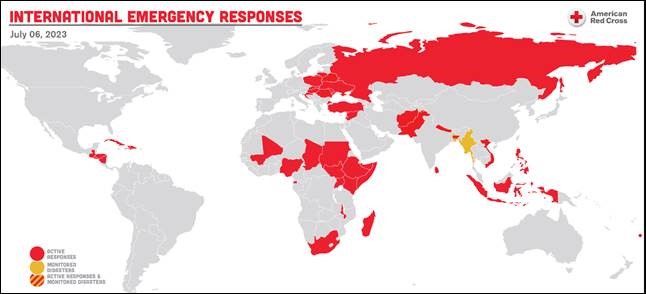
The International Services Monthly Activity Update provides a brief snapshot of significant international disaster events that the American Red Cross is currently responding to and monitoring. This update will also feature clips of stories, blog posts and photos published on redcross.org and affiliated sites about our ongoing international work. Information within this report is compiled from several sources including the International Federation of Red Cross and Red Crescent Societies, the UN Office for the Coordination of Humanitarian Affairs, the U.S. Agency for International Development and involved Red Cross and Red Crescent national societies.
Canada – Wildfires (Monitoring – Not Actively Responding)
Wildfires across Canada are having a record-setting year in 2023, burning millions of acres across the country. On May 6, 2023, the province of Alberta was the first to declare a state of emergency as more than 90 wildfires burned in the northern part of the province. Numerous communities and tens of thousands of people were on evacuation orders or alerts. The fires continued to burn coast to coast and now have begun to impact Nova Scotia and Atlantic Canada, resulting in mass evacuations.
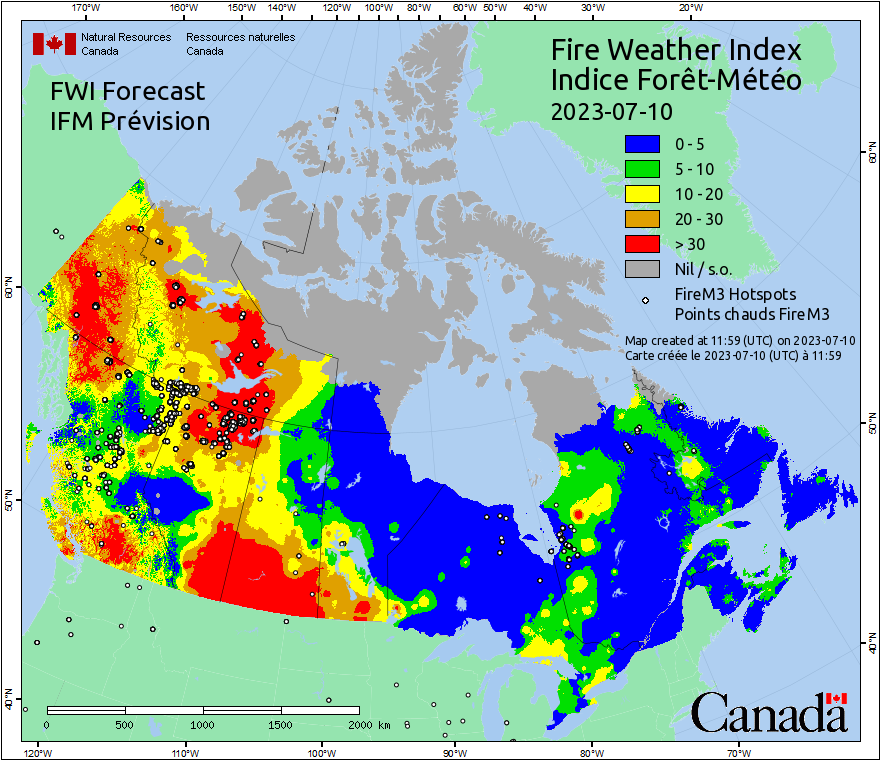
Source: Canadian Government Fire Hotspots Maps
As of late June, more than 480 wildfires continued to burn in Canada. More than half of these fires have been burning out of control and already consumed as many as 7.9 million acres.
These dangerous wildfires are causing significant damage and sending tremendous amounts of smoke into the atmosphere. The thick bands of smoke from the wildfires in Canada have affected much of the United States during the month of June and stretching as far as Europe.

Photo: American Red Cross of Eastern New York
The Canadian Red Cross is on the ground assisting communities affected by the fires. The Canadian Red Cross in coordination with government authorities has mobilized teams to support the response by opening shelters and comfort centers for people forced from their homes; providing people with basic necessities like food and clothing; and as the situation continues to develop, providing psychosocial support to affected individuals to help cope with hardship and loss. As people return to their homes, the Canadian Red Cross is also working closely with their government to provide financial assistance to people affected by the fires.
International Assistance has not been requested. However, the American Red Cross is monitoring the situation in coordination with the Canadian Red Cross.
Italy – Floods (Monitoring – Not Actively Responding)
In the Emilia-Romagna region of Northern Italy, a total of 80 hours of rainfall occurred from significant and prolonged storms in the beginning part of May. The increased rainfall continued throughout the month and resulted in severe flooding across the region. This flooding caused more than 20 rivers to overflow and triggered thousands of landslides which resulted in casualties and widespread damage. Italian authorities have reported 36,000 people have evacuated and more than 500 roads have been closed across the region due to landslides.
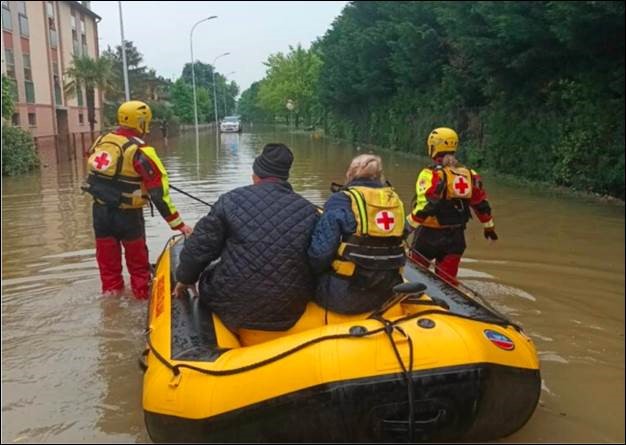
Photo: Italian Red Cross
The Italian Red Cross has mobilized more than 400 Red Cross volunteers and staff, including volunteers specialized in rescue in flood environments, to support the rescue and relief operation in the region. They have been supporting vital services emergency rescue, evacuation operations, emergency sheltering and other critical services. The Italian Red Cross has also mobilized health and mental health teams to provide assistance to people affected by this disaster. Hundreds of vehicles such as bobcats, mini-excavators, water pumps, field kitchens and ambulances have been supporting clean up and evacuation of affected communities.
The President of the Italian Red Cross, Rosario Valastro, expressed his heartfelt recognition towards all the rescuers who are working to help the affected population and territories. “We are deeply concerned and sympathetic to the people experiencing dramatic hours. Also in this emergency, as always, the Italian Red Cross, operating within the Civil Protection system, provides trained operators and the means to guarantee immediate assistance.”
International assistance has not been requested, and the American Red Cross is not accepting donations.
Malawi – Tropical Cyclone Freddy
Tropical Cyclone Freddy made landfall on February 21 on the eastern coast of Madagascar, near Mananjary. Tropical Cyclone Freddy made landfall on March 11 close to the border between Mozambique and the southern tip of Malawi. The weather system slightly weakened before landing but sustained wind gusts of more than 110 mph, causing a storm surge and damage to houses and critical infrastructure, including schools.
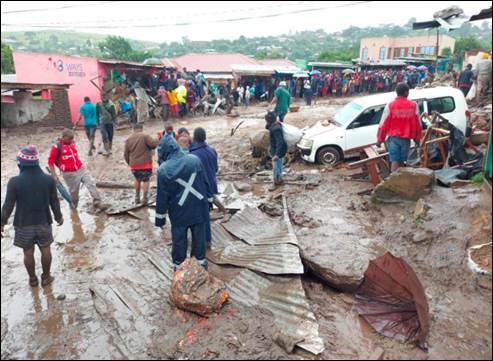
The impact from Tropical Storm Freddy in Southern Malawi.
Photo: IFRC
According to Malawi’s Department of Disaster Management Affairs (DoDMA), more than 500 people lost their lives and approximately 286,000 people have been displaced in the hardest-hit districts. In addition, more than 190,000 livestock are dead with over 490,000 acres of agricultural land severely impacted. Such impact on the livestock and agricultural produce has further aggravated the concurrent food insecurity across Malawi. An estimated 3.8 million people in Malawi are facing severe acute food insecurity, with high food prices, the depletion of food stocks, and the lean season (November–March). In urban areas, the disaster has shocked the normal daily income generating businesses and other services required for daily living. Some markets are currently inaccessible due to poor access while the few shops that are reachable are showing high inflation due to increased demand.
OCHA reports over 500 schools were damaged or destroyed, thereby impacting over 270,000 learners. Some of the schools are used as camps for humanitarian relief and resources. Malawi is concurrently impacted by the cholera outbreak. It is projected that the adverse impact of Cyclone Freddy on water, sanitation, and hygiene infrastructure will only exacerbate the cholera outbreak and the public hygiene.
Through an Emergency Appeal, the International Federation of Red Cross and Red Crescent Societies (IFRC) is seeking 6 million CHF over 9 months to support the Malawi Red Cross Society to meet the needs of up to 160,000 people affected by food insecurity. The appeal focuses on livelihood and basic needs; health and nutrition; water, sanitation and hygiene; protection, gender, and inclusion; community, engagement and accountability; and disaster risk reduction.
The American Red Cross has contributed $420,000 to the IFRC emergency appeal to assist the Malawi Red Cross Society in facilitating access to cash voucher assistance to meet the immediate needs of vulnerable people affected by the floods. The American Red Cross also sent a Response Lead to Malwai to evaluate the ongoing response activities. This includes a visit to some of the shelters built in the aftermath of Tropical Storm Ana with the support of the American Red Cross. These shelters were able to withstand the impact of Tropical Cyclone Freddy. Meanwhile they supported a coordinated call with USAID to provide an update on the global Red Cross response in Malawi. More than 3 months after the storm’s impact, Red Cross activities reliefs remain ongoing to aid cyclone affected communities.
Mediterranean – Migration Crisis
On Wednesday June 14, a fishing boat capsized in international waters more than 50 miles southwest of Pylos in southern Greece, in one of the deepest areas in the Mediterranean. It was anticipated that 400 – 750 people were onboard, but only 100 individuals were able to be rescued. The remaining passengers were found deceased or are missing and believed to be dead. This is the deadliest shipwreck off Greece in several years – the first quarter of 2023 has been the deadliest in Central Mediterranean since 2017.
The boat had sailed from the Libyan town of Tobruk, which lies south of the Greek island of Crete, with most on board being young men in their 20s. The Coast Guard said the boat, which was heading towards Italy, was spotted in international waters late on June 13 by an aircraft belonging to European Union border agency, Frontex and two nearby vessels. It said those on board had refused assistance offered by Greek authorities. A few hours later the boat capsized and sank, triggering a massive search-and-rescue operation mounted by the Hellenic Coast Guard.
The Hellenic Red Cross (HRC), with the specialized nursing staff and the volunteers of the Health Sector of the Kalamata Regional Department assisted from the first moment the survivors of the wreck. Volunteer Samaritans-Rescuers of the HRC were also deployed and supported more than 80 migrants (including 20 children), providing first aid and distributing food and basic necessities while offering psychological support to the rescued migrants. The main health problems faced are secondary drowning, shortness of breath, dehydration, asthma attacks, high fever, exhaustion, dysuria, hematuria, and otitis.
The crisis in the Mediterranean has been ongoing as early as 2014 with millions of people fleeing violence, economic insecurity, and many other complex reasons. The American Red Cross has long supported this response with financial and human resources support, most recently deploying four specialists across several years starting in 2021. These four specialists were stationed on rescue ships to help migrants who have made this dangerous journey. The American Red Cross will continue to monitor the situation in coordination with the global Red Cross and Red Crescent Network.
As the world’s largest humanitarian network, Red Cross and Red Crescent teams have long delivered relief to refugees, migrants and asylum seekers around the globe. The American Red Cross, along with the global Red Cross and Red Crescent network, are guided by the seven fundamental principles of humanity, impartiality, neutrality, independence, voluntary service, unity and universality. This means we provide services to people who need them in times of emergency—regardless of race, religion, gender identity, sexual orientation or citizenship status. More information about how the American Red Cross helps migrants, refugees and asylum seekers can be found here.
Myanmar – Tropical Cyclone Mocha
Tropical Cyclone Mocha made landfall on May 14, 2023 in Myanmar as an extremely severe cyclonic storm with winds gusting up to 155 mph. The tropical cyclone caused storm surges in excess of six feet, strong winds and very significant rainfall with heavy inundation reported in low-lying areas of Rakhine, particularly in and around the state capital Sittwe. Houses, sanitation facilities, and public infrastructure were damaged or destroyed by the cyclone, including hospitals, transport infrastructure (e.g., roads and airports), a water dam, and agricultural land while equipment was washed away.
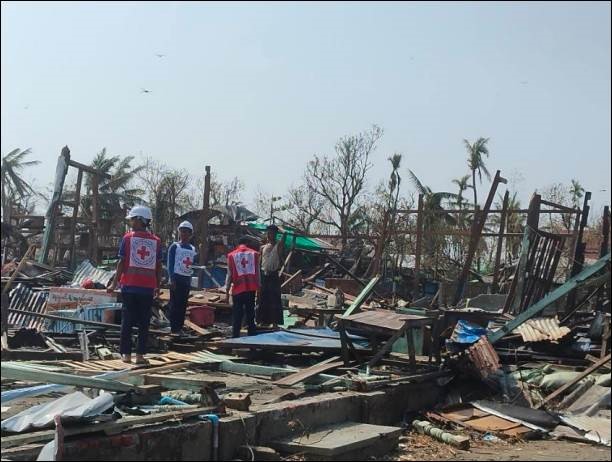
Myanmar Red Cross Society volunteers observing the damage by Cyclone Mocha in Thet Kal Pyin village in Sittwe Township, Rakhine State.
Photo: Myanmar Red Cross Society
According to the Myanmar Red Cross Society (MRCS), over 1.1 million individuals from over 237,000 households were affected. A large number of semi-permanent and temporary shelters were damaged or destroyed, leaving over 200,000 houses in need of repair. In addition, water systems, sanitation facilities, public and community infrastructure, including hospitals, clinics, schools, and religious buildings, as well as transportation infrastructure, suffered severe damage or complete destruction.
The cyclone’s aftermath has led to increased prices of basic goods, and the situation has taken a toll on the physical and mental health of the affected population. Disrupted access to healthcare, medicine shortages, and the risks posed by landmines in flooded conflict areas further exacerbate the challenges. Urgent measures are required to protect and support unaccompanied children, the needs of women and girls and other populations in situations of vulnerability.
Since February 2021, the overall country context in Myanmar has been complex and insecure due to the extent of civic disorder and armed clashes. The economic situation remains fragile and almost half the population in the country is estimated to be living in poverty due to the political crisis and the preexisting impacts of the COVID-19 pandemic. In Rakhine state and the Northwest area, there were already an estimated six million people in need of humanitarian assistance and 1.2 million people internally displaced. The impact of the cyclone is expected to exacerbate such pre-existing vulnerabilities, especially for the displaced.
The IFRC released an Emergency Appeal for CHF 5 million over 12 months to support the Myanmar Red Cross Society to meet the needs of up to 37,500 people affected by the cyclone. The appeal focuses on livelihood and basic needs; multi-purpose cash assistance; health and nutrition; water, sanitation and hygiene; protection, gender, and inclusion; community, engagement and accountability; and disaster risk reduction.
The American Red Cross has contributed $300,000 to the IFRC emergency appeal to support the efforts of the Myanmar Red Cross Society.
Pakistan – Monsoon Floods
During the 2022 monsoon season, Pakistan faced its worst flooding in decades. Unprecedented monsoon rains started in June 2022 and tripled the national 30-year average. The Government of Pakistan officially declared a national emergency on August 25, 2022. The rains caused widespread flooding and landslides, with severe impacts on livelihoods, homes, and infrastructure.
More than 33 million people were impacted by the floods, triggering waves of displacement and an increase in water-borne diseases and food inaccessibility. According to the country’s National Disaster Management Authority over 1,700 people, including 630 children, died and at least 13,000 people were injured.
Nearly a year since the floods, Pakistan is currently facing an imminent nutrition crisis, which has been aggravated by pre-existing high rates of malnutrition in flood-affected regions. Of particular concern is the increasing malnutrition among young children, as undernutrition accounts for nearly half of all deaths in children under five. Twenty percent of children under five in Pakistan suffer from severe and moderate acute malnutrition rates at 8 percent and 9.7 percent, respectively.
According to WHO (World Health Organization), around 8 million flood-affected people need healthcare assistance, with risks of the number increasing as the displaced population slowly returning to their communities with damaged infrastructure, inadequate access to safe water and sanitation facilities, and stagnant water. Families are left with no option but to consume and use potentially contaminated water as around 10 million. Individuals still lack access to a secure source of drinking water. This has increased the risk of waterborne illnesses among these affected communities. With summer approaching, the need for immediate assistance to combat the weather is dire. Access to necessities of shelter, food and household items is further heightened especially in the context of extreme temperature changes, especially in the province of Sindh.
“Our children started to fall sick, one after the other following the floods. We were stranded here with no roof over our heads and no access to hospitals. We were distraught and couldn’t think straight,” said one of the residents of Dadu District, Sindh.
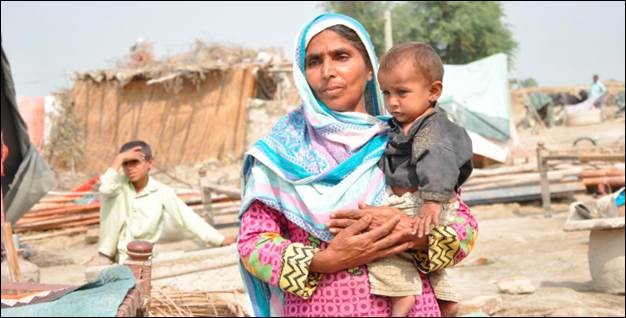
Photo: IFRC
In 2023, the heavy monsoon rains have returned and are causing damage to a country that has already experienced devastating floods. Since May 2023, Pakistan has experienced by heavy rain, severe sandstorms, thunderstorms, and hailstorms, causing extensive damage to properties and crops. On June 10, at least 31 people were killed and 160 were injured by rain-related incidents in Khyber Pakhtunkhwa and Punjab. The districts of Bannu, Dera Ismail Khan, Karak, and Lakki Marwat reported 28 fatalities, while three schools suffered partial damage and two houses were destroyed.
Monsoon season in Pakistan officially started at the beginning of July and will continue until September. However, based on the pre-season flooding that has already occurred, flooding and landslides are expected again this year and could cause even more damage to areas that were impacted last year.
The IFRC released an Emergency Appeal for 40 million CHF to support the Pakistan Red Crescent Society. The IFRC aims to assist one million people over 16 months through this emergency appeal. The priority areas of support include preventative public health interventions, including rehabilitation of water and sanitation facilities and hygiene campaigns for the prevention of disease transmission; increased access to health services; maternal and child health care interventions; shelter items and winterization support in cold areas; and assistance to meet basic needs and recover livelihoods. Following last year’s floods, the Pakistan Red Crescent used its learnings to train it’s staff and volunteers as well as pre-position supplies at its provincial branches to better respond to future flood emergencies.
The American Red Cross has contributed $382,000 to the IFRC emergency appeal, bringing the total contribution to $682,000, to assist the Pakistan Red Crescent Society in providing cash and voucher assistance for food security and livelihoods; and water, sanitation and hygiene needs to meet some of the needs of those affected by the flood. The American Red Cross also provided technical support to the operation by deploying a disaster response specialist to support operational coordination.
Sri Lanka – Complex Emergency
An economic crisis compounded by several factors sparked civil unrest and food insecurity in Sri Lanka. The containment measures implemented during the COVID-19 pandemic adversely affected Sri Lanka’s tourism sector, foreign direct investment (FDI), and trade, resulting in a rapid decline of foreign currency income for the country.
The current crisis in Sri Lanka is affecting the public, private and social sectors and has created the conditions for increased vulnerability, poverty, and destitution. In October 2022, approximately 9.6 million people fell below the international poverty line for lower-and-middle-income countries. More than 60 percent of families are eating less and eating cheaper, low-nutritious foods. This comes at a time when financial constraints have forced the government to scale back on nutrition programs, such as school meals and fortified food to mothers and undernourished children. According to UN OCHA (United Nations Office for the Coordination of Humanitarian Affairs), an estimated 5.7 million people or more are now in need of humanitarian assistance, with at least 4.9 million being food insecure.
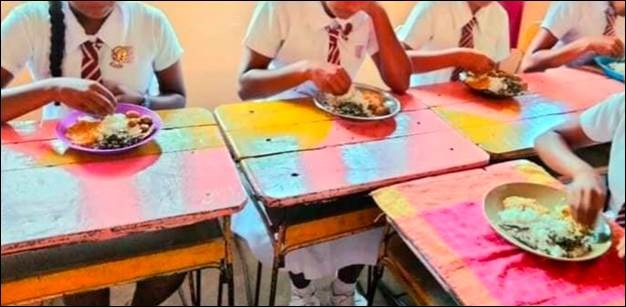
School Children having nutritional foods under the school feeding program in Kandy district. Sri Lanka Red Cross Society has initiated a ‘School Feeding’ program in thirteen districts.
Photo: Sri Lankan Red Cross Society
The Government of Sri Lanka announced several tax increases to reduce the fiscal deficit and limited the import of essential items to save its foreign currency reserves. Protests erupted due to the resulting shortages and sharp increase in food prices including milk, dhal/lentils, locally produced vegetables, rice, bread, wheat flour, cooking gas, fertilizer, and fuel. Medications and medical consumables are also in short supply.
The IFRC issued an Emergency Appeal of CHF 28 million appeal over 18 months to assist up to 500,000 people. The appeal focuses on livelihood and basic needs; health and nutrition; water, sanitation, and hygiene; protection, gender, and inclusion; disaster risk reduction; education; and community engagement and accountability.
The American Red Cross has contributed $300,000 to the IFRC emergency appeal to assist the Sri Lankan Red Cross Society in providing cash and voucher assistance and nutritious food for school children to meet the needs of those affected by the emergency.
Ukraine – Humanitarian Crisis
It has been more than 500 days since the Ukrainian Humanitarian Crisis amplified. Armed conflict continues in Ukraine and the humanitarian needs are spreading to many countries across Europe and around the world. It is estimated that the number of people affected by the ongoing crisis is approximately 27 million inside and outside of Ukraine.
People affected by the ongoing conflict in Ukraine are living in damaged buildings that do not offer protection from harsh weather conditions. Communities are without power, running water, and heating in parts of the country, with many struggling to access drinking water and food. Displacement, severed familial connections, witnessing atrocities, and other life-threatening events have immense and often long-lasting negative consequences on people’s mental health.
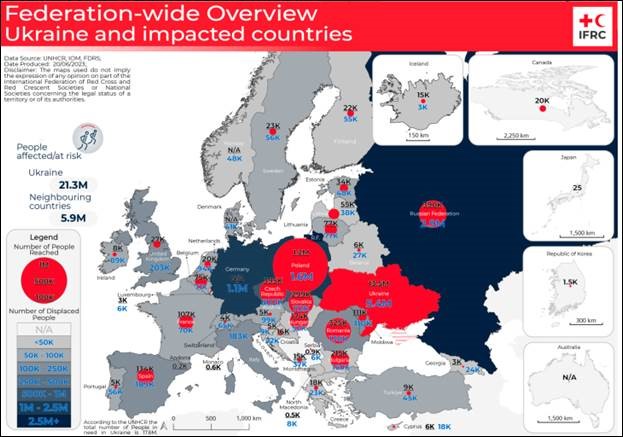
Federation-Wide Response Overview as of June 20, 2023.
Photo: IFRC
In addition to the immediate suffering caused by the conflict, there are broader dimensions to its impact. This includes damage to civilian infrastructure in Ukraine, such as hospitals and schools, disruption to food production and exports, mass displacement within the region, and increased risks of conflict-related sexual violence, trafficking for exploitation, abuse of people in vulnerable situations, and violence related to displacement.
The impacts of the ongoing hostilities are not limited to those directly affected by the conflict: communities worldwide, in particular host communities, experience difficulties due to protracted displacement and economic crisis that have exacerbated pre-existing vulnerabilities. Already under immense pressure from the COVID-19 pandemic and global economic downturn, public health and social security systems in host communities have been further stressed by the international armed conflict between the Russian Federation and Ukraine. Within this environment of overlapping crises, the humanitarian implications grow, generating protracted and diversified needs within health, migration, shelter, and livelihoods – all of which demand a comprehensive response.
Currently, the IFRC funding requirements for this emergency appeal are 800 million CHF. The operation now supports 18 National Societies and their response plans targeting 22.6 million affected people. The Federation-wide response is focused on health and care; mental health and psychosocial support; water, sanitation and hygiene; shelter, housing and settlements; livelihoods; multi-purpose cash; protection, gender and inclusion; community engagement and accountability; and migration.
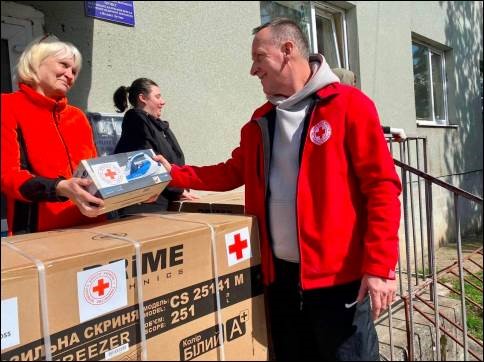
Ukrainian Red Cross Society (URCS) volunteers provide shelter with household appliances to the shelter for internally displaced persons located in the village of Velyki Luchky, Mukachevo district, to provide assistance and improve the living conditions of people who have been forced to leave their homes and have taken refuge in a compact settlement, making them more comfortable.
Photo: URCS
As of early February 2023, the American Red Cross has spent or made commitments to spend $101.5 million $148 million to the Ukraine Humanitarian Crisis and remain committed to assist with the immediate and ongoing relief efforts as this crisis continues to develop.
Recent International Stories
World Refugee Day 2023: Three Stories of Hope Away from Home – June 19, 2023
Last year, more than 100 million people were forcibly displaced globally — a record number propelled by the war in Ukraine and other conflicts around the world. To recognize the strength and courage of those forced to flee their home countries, World Refugee Day was celebrated on June 20.
Three U.S. Nurses Receive Highest Red Cross International Nursing Medal – June 8, 2023
Three nurses from the United States – Captain Brandi Branch, Patricia Chappell, and Captain Carlos Mendoza – are among this year’s recipients of the Florence Nightingale Medal, the highest Red Cross international distinction a nurse can receive.
To Learn More About Our Work at Home and Around the World: The American Red Cross shelters, feeds and provides emotional support to victims of disasters; supplies about 40 percent of the nation’s blood; teaches skills that save lives; provides international humanitarian aid; and supports military members and their families. The Red Cross is a not-for-profit organization that depends on volunteers and the generosity of the American public to perform its mission. For more information, please visit redcross.org or visit us on Twitter at @RedCross.

